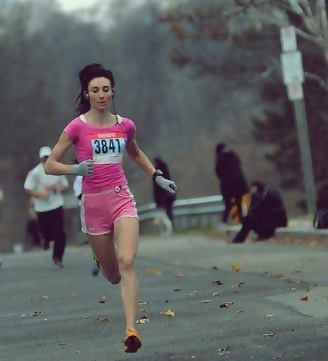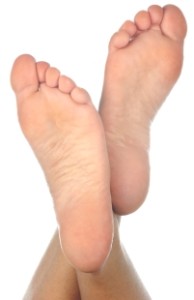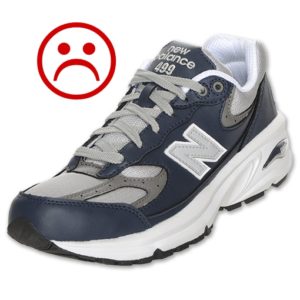Most runners heel strike, while other runners, specially elite runners land with a forefoot strike, so why do runners heel strike?
Why runners heel strike and some don’t?
The predominate foot strike in habitually shod runners is a heel strike whereas the predominant foot strike in habitually barefoot running populations is a forefoot strike. Therefore, athletic footwear plays a dominant role in influencing foot strike pattern in runners.

Why Do Runners Heel Strike
Mounting data has pointed out that thick heeled running shoes facilitates a heel strike running style. Shoe cushioning also blocks sensory input at the feet thereby influencing inadequate foot strike behavior.

Why plantar sensory input is important for running safely:
- promotes adequate foot strike modification behavior to avoid high-impact landings
- detects surface irregularities/hardness to help the central nervous system make adjustments in knee/ankle stiffness, allowing for softer landings
Blocking plantar sensory input impairs foot strike mechanics during running, causing you to run with greater impact.
- cushioned running shoes inhibit the proprioceptors in the feet resulting in poor detection of surface characteristics during forefoot running
The landings may feel soft due to shoe cushioning, however the impact produced from the body/ground interaction remains high.
Unlike barefoot conditions, wearing heavily cushioned shoes will cause you to interact more aggressively with the ground thereby generating higher impact without even knowing it.
How Thick Heeled Running Shoes Facilitate Heel Strike
The higher the heel of a running shoe, the more likely a runner is to heel strike.
Researchers at Harvard University reported in the Journal of Medicine and Science in Sports and Exercise, 2012, that elevated heeled footwear encourages a longer stride and eliminates dorsiflexion during running.
The foot is held in a position that prevents the forefoot from making initial contact with the ground, which would have been followed by the lowering of the heel to the ground in the absence of a cushioned heel.
This natural movement pattern of the foot in a forefoot strike landing may be fundamental in running with respect to injury prevention as braking, impact transient, and collision forces are dramatically reduced.
Humans are Barefoot Running Creatures
Hominids (our ancestors) ran long distances barefoot whereby most barefoot and minimalist runners land with a forefoot strike.
- forefoot striking allows barefoot running to feel comfortable regardless of surface hardness since the impact transient related to heel strike running is eliminated
Unfortunately, most runners today have no experience with barefoot running. Therefore, the innate ability to run forefoot properly is diminished, but can be revived with proper instruction and graded barefoot running.
Humans Did Not Evolve to Run on the Heels Barefoot, or In Shoes
 Even though heel striking is a form of high-impact running, a shoe with a large, cushioned heel allows heel striking to feel comfortable than running barefoot on the heels.
Even though heel striking is a form of high-impact running, a shoe with a large, cushioned heel allows heel striking to feel comfortable than running barefoot on the heels.
Other researchers hypothesized that if humans evolved to run barefoot, most likely as forefoot strikers, than natural selection did not adapt the human body to run with a heel strike in shoes. This may be the reason heel strikers have a higher rate of repetitive stress injuries as selective pressures have not yet enabled humans to adapt to this style of running.
More From Run Forefoot:
- Running Shoes that Impair Running Form and Cause Injury
- Heel Strike Running vs Forefoot Strike Running
- Heel Striking is Dangerous
- Dangers of Heel Striking in a Minimalist Shoe
- Achilles Tendonitis and Forefoot Strike Running
References:
Hasegawa et al. Foot strike patterns of runners at the 15-km point during an elite-level half marathon. J Strength Cond Res Natl Strength Cond Assoc 2007; 21, 888-93.
Lohman EB, Balan Sackiriyas KS, Swen RW. A comparison of the spatiotemporal parameters, kinematics, and biomechanics between shod, unshod, and minimally supported running as compared to walking. Phys Ther Sport Off J Assoc Chart Physiother Sports Med 2011;12:151 e 63.
Robbins SE, and Gouw GJ. Athletic footwear: unsafe due to perceptual illusions. Medicine and Science in Sports and Exercise. 1991.
Bretta Riches
BSc Neurobiology; MSc Biomechanics candidate, ultra minimalist runner & founder of RunForefoot. I was a heel striker, always injured. I was inspired by the great Tirunesh Dibaba to try forefoot running. Now, I'm injury free. This is why I launched Run Forefoot, to advocate the health & performance benefits of forefoot running and to raise awareness on the dangers of heel striking, because the world needs to know.
Latest posts by Bretta Riches (see all)
- Heel Lifts Increase Injury in Runners - 16/04/2024
- Are Minimalist Shoes Good for Seniors? YES! - 14/04/2024
- BIG Deals On Running Gear And More! - 09/04/2024

Leave a Reply